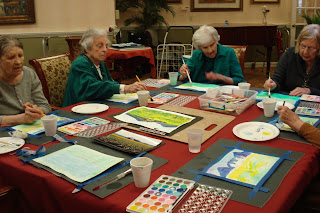I recently started a new Watercolor class for my residents at Silverado Senior Living in Plano,TX. My students at Silverado are all in different stages of Alzheimer's and have different ability levels and attention spans, so I was not sure how well they would be able to work in Watercolor or if they would end up with a good finished piece.
I find that Memory Care classes require more pre-planning than my other classes and I actually complete the first five steps of this list before beginning the class with my students.
10 Steps for teaching a Watercolor Class to Memory Care Residents:
1. Enlarge a photo or choose a large picture from an art book that does not have a lot of fine detail. I enlarged this photo that I had taken in Washington state of a field of daffodils and mounted it on black card stock so they could easily see the photo.
 |
| Early Spring in Washington State |
2. Paint a sample watercolor painting for students to refer to- nothing too fancy- to show them what their finished picture can look like. I used a combination of watercolor, color pencils and ink for my painting.
 |
| Sample painting |
3. Sketch out the basic scene on each student's sheet.
4. Color code the different areas of the painting because these additional instructions are very helpful.
I found this really made it easier for my students to follow my directions as we painted each section, so will include these prompts on everyone's drawing in the future.
5. Use foam board or thin plywood scrap as a backer for the watercolor paper, and tape everyone's paper to the board before class.
6. Set up each individual's watercolor paints, brushes, water and palette for them. Show them the sample painting so that they can see what the final product is supposed to look like and make sure they do not jump ahead before they are shown what the next step should be.
7. Give step by step instructions and demonstrate each step so that students can see what you are asking them to do. Our project was a "wet on wet" painting, so I showed them how to do a wash with clear water using a large flat brush and made sure they did not soak the paper with too much excess water. As I gave them each new instruction, I demonstrated each step as we went along.
8. Show students how to pick up color from the paint palette and how to mix paint colors on the palette to create custom colors. We painted each section separately, painting the sky first at the top, moved to lower areas next so that each section would have time to dry a little so the colors would not all run together.
 |
| Getting Started |
9. Assist students if they have questions, but allow them to choose their own color schemes if they do not want to follow the prompts- and have each person complete each section on their own if possible-after all there is no right or wrong way to create art!
 |
| Making Good Progress on our Paintings! | |
|
 |
| Adding More Details |
 |
| Creating One-of-a-kind Masterpieces! |
10. After all the sections of the paintings are finished by your students, you can define a few details with ink or pencil if you choose. I drew in a few details with ink and it really made a huge difference in the final painting- and all my ladies were very pleased with their final results. Always make sure to have them sign their names on their paintings so that they can show their families what they have accomplished.
I was very pleased at the results of our first class. The ladies were engaged for over an hour and really enjoyed creating their own masterpieces. I do a lot of art and gardening classes with Memory Care residents, and feel this was one of the best activities we have completed together to date and really look forward to doing another watercolor project with them next month,
Till next time- Stay Engaged in Life and Be Creative!
Stephane

